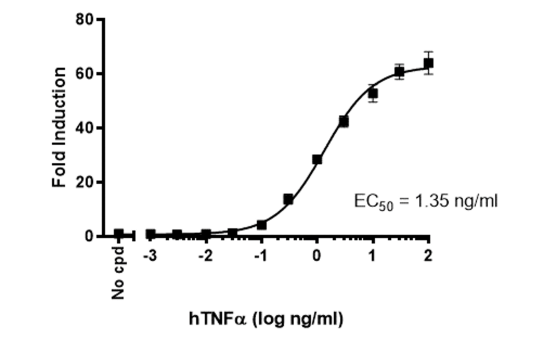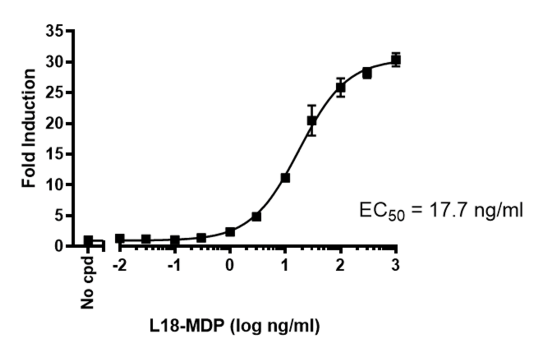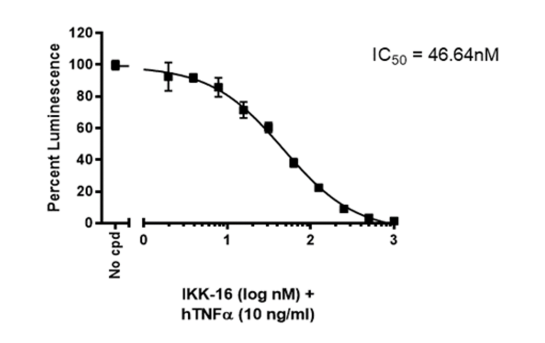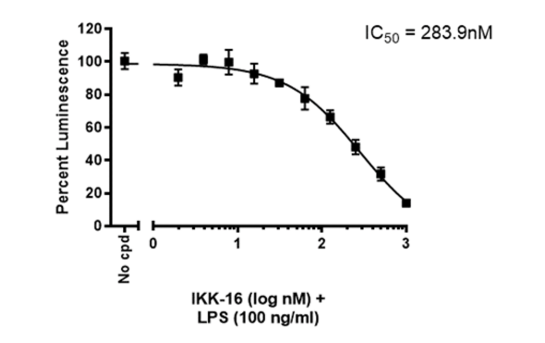NF- κB Reporter (Luc) – THP-1 Cell Line
The NF-κB reporter (Luc)-THP-1 cell line is designed for monitoring NF-κB (nuclear factor κB) signal transduction pathways. It contains a firefly luciferase gene driven by four copies of the NF-κB response element located upstream of the minimal TATA promoter. After activation by pro-inflammatory cytokines or NOD agonists, endogenous NF-κB transcription factors bind to the DNA response elements, inducing transcription of the luciferase reporter gene.
Interested in screening and profiling inhibitors, blocking antibodies, or activators of NF-κB-mediated signaling without the need to purchase and license the cell line? Check out our Cell Signaling Pathway Screening.
Purchase of this cell line is for research purposes only; commercial use requires a separate license. View the full terms and conditions.
Materials Required for Cell Culture
| Name | Ordering Information |
| Thaw Medium 8 | BPS Bioscience #79652 |
| Growth Medium 8A | BPS Bioscience #79653 |
Materials Required for Cellular Assay
| Name | Ordering Information |
| Recombinant Human hTNFα | R&D Systems #210-TA |
| LPS-EK (TLR4 and TLR2 agonist) | Invivogen #tlrl-eklps |
| L18-MDP (NOD2 agonist) | Invivogen #tlrl-lmdp |
| IKK-16 dihydrochloride | Sigma #SML1138 |
| Assay Medium: Thaw Medium 8 | BPS Bioscience #79652 |
| 96-well tissue culture-treated white clear-bottom assay plate | Corning #3610 |
| ONE-Step™ luciferase assay system | BPS Bioscience #60690 |
| Luminometer |
The cell line has been screened to confirm the absence of Mycoplasma species
The role of NF-κB (nuclear factor-κB) activation is well-characterized in canonical (classical) and noncanonical (alternative) signaling pathways of inflammation. Two major forms of innate immune sensors are Toll-like receptors (TLR) and NOD/CATERPILLAR proteins. Mutations in NOD2 (nucleotide-binding oligomerization domain-containing protein 2) have been linked to chronic autoinflammatory and autoimmune diseases, such as Crohn’s disease and Blaus syndrome. Studying the canonical and noncanonical NF-κB pathways and the influence of TLR pathways and NOD2 mutations can further our understanding of autoimmune regulation.
- Pessara U, Koch N (1990) Tumor necrosis factor alpha regulates expression of the major histocompatibility complex class II-associated invariant chain by binding of an NF-κB-like factor to a promoter element. Mol Cell Biol. 10(8):4146-4154.
- Baeuerle PA (1998) Pro-inflammatory signaling: last pieces in the NF-κB puzzle? Curr Biol. 8(1):R19-R22.
- Pan, Q., Kravchenko, V., Katz, A., Huang, S., Ii, M., Mathison, J. C., Kobayashi, K., Flavell, R. A., Schreiber, R. D., Goeddel, D., & Ulevitch, R. J. (2006). NF-κB-Inducing Kinase Regulates Selected Gene Expression in the Nod2 Signaling Pathway. Infection and Immunity, 74(4), 2121–2127.






